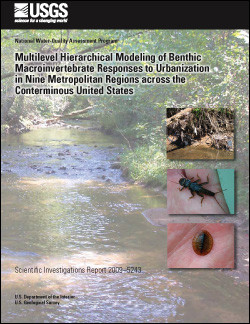
Product Details
- Product Number
- 116705
- Series
- SIR-2009-5243
- Scale
- NO SCALE
- Alternate ID
- SIR-2009-5243
- ISBN
- 978-1-4113-2675-0
- Authors
- BOKNAM LEE
- Version Date
- 01/01/2010
- Countries
- USA
- Media
- Paper
- Format
- Bound
Additional Details
- Description
-
ABSTRACT
Multilevel hierarchical modeling methodology has been developed for use in ecological data analysis. The effect of urbanization on stream macroinvertebrate communities was measured across a gradient of basins in each of nine metropolitan regions across the conterminous United States. The hierarchical nature of this dataset was harnessed in a multi-tiered model structure, predicting both invertebrate response at the basin scale and differences in invertebrate response at the region scale. Ordination site scores, total taxa richness, Ephemeroptera, Plecoptera, Trichoptera (EPT) taxa richness, and richness-weighted mean tolerance of organisms at a site were used to describe invertebrate responses. Percentage of urban land cover was used as a basin-level predictor variable. Regional mean precipitation, air temperature, and antecedent agriculture were used as region-level predictor variables. Multilevel hierarchical models were fit to both levels of data simultaneously, borrowing statistical strength from the complete dataset to reduce uncertainty in regional coefficient estimates. Additionally, whereas non-hierarchical regressions were only able to show differing relations between invertebrate responses and urban intensity separately for each region, the multilevel hierarchical regressions were able to explain and quantify those differences within a single model. In this way, this modeling approach directly establishes the importance of antecedent agricultural conditions in masking the response of invertebrates to urbanization in metropolitan regions such as Milwaukee#Green Bay, Wisconsin; Denver, Colorado; and Dallas#Fort Worth, Texas. Also, these models show that regions with high precipitation, such as Atlanta, Georgia; Birmingham, Alabama; and Portland, Oregon, start out with better regional background conditions of invertebrates prior to urbanization but experience faster negative rates of change with urbanization. Ultimately, this urbanization-invertebrate response example is used to detail the multilevel hierarchical construction methodology, showing how the result is a set of models that are both statistically more rigorous and ecologically more interpretable than simple linear regression models.
- Height In Inches
- 11.000
- Width In Inches
- 0.250
- Length In Inches
- 8.500
- Two Sided
- Yes
- Pieces
- 1




